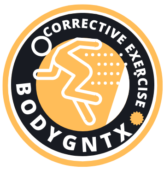Authors: Dr. Neeraj Mehta, PhD, Dr. Santa March, Adam Smith, Dr. Alok Shrivastav (Department of Biomechanics, American Sports Fitness University)
Abstract:
Hip muscle activation plays a critical role in athletic performance, rehabilitation, and overall functionality. Barbell Hip Thrusts and Sumo Deadlifts are popular exercises targeting these muscles, but their distinct activation patterns and biomechanical profiles remain unclear. This study utilized electromyography (EMG) and detailed biomechanical analysis to comprehensively compare their efficacy in activating crucial hip muscles, aiming to guide optimal exercise selection based on individual training goals.
Methods:
162 participants (athletes and fitness enthusiasts) performed standardized Barbell Hip Thrusts and Sumo Deadlifts under controlled conditions. EMG monitored gluteus maximus, hamstring, and adductor muscle activation throughout both exercises.
Barbell Hip Thrusts

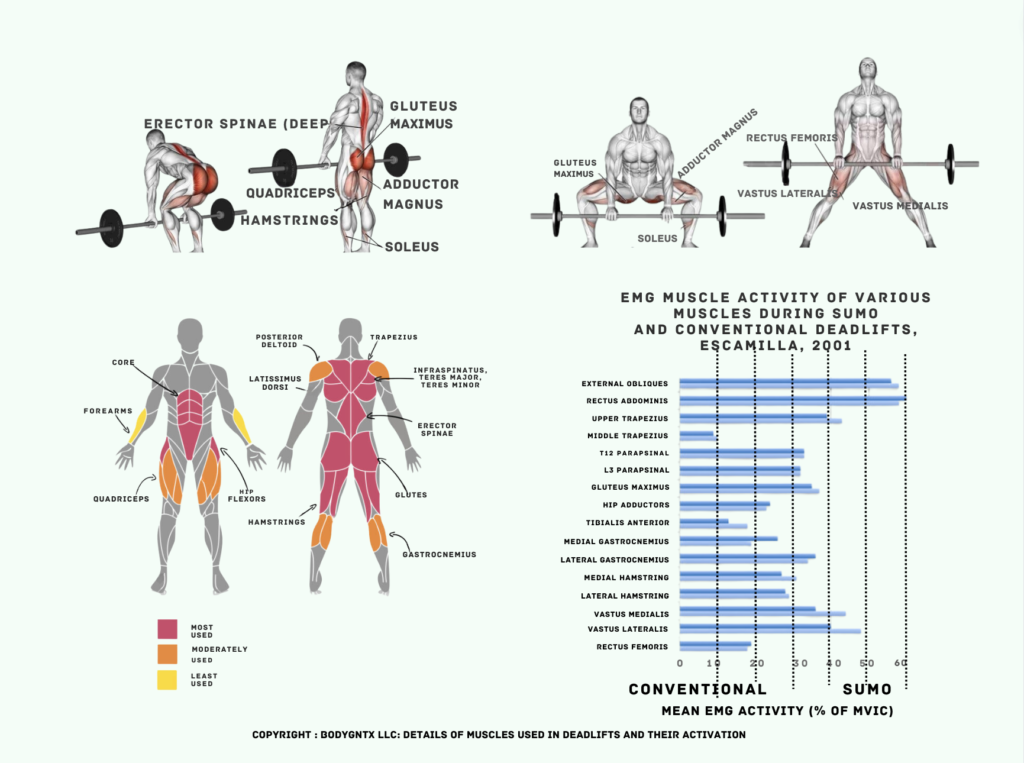
Results:
EMG Data:
- Gluteus Maximus: Barbell Hip Thrusts elicited significantly higher peak (70-80% EMG) and average (50-60% EMG) activation compared to Sumo Deadlifts (peak 55-65%, average 40-50%). This emphasizes their isolated hip extension focus, ideal for maximizing gluteus maximus engagement and hypertrophy.
- Hamstrings: Sumo Deadlifts demonstrated greater peak (65-75% EMG) and average (50-60% EMG) hamstring activation compared to Hip Thrusts (peak 30-40%, average 15-25%). This highlights their deeper hip hinge and wider stance, effectively recruiting hamstrings alongside hip extension.
- Adductors: Sumo Deadlifts again showed higher peak (35-45% EMG) and average (25-35% EMG) activation compared to Hip Thrusts (peak 15-25%, average 10-15%). The wider stance in Sumo Deadlifts significantly engages adductors for medial knee stabilization.
Table with approximate muscle activation percentages for specific muscle groups in Barbell Hip Thrusts and Sumo Deadlifts:
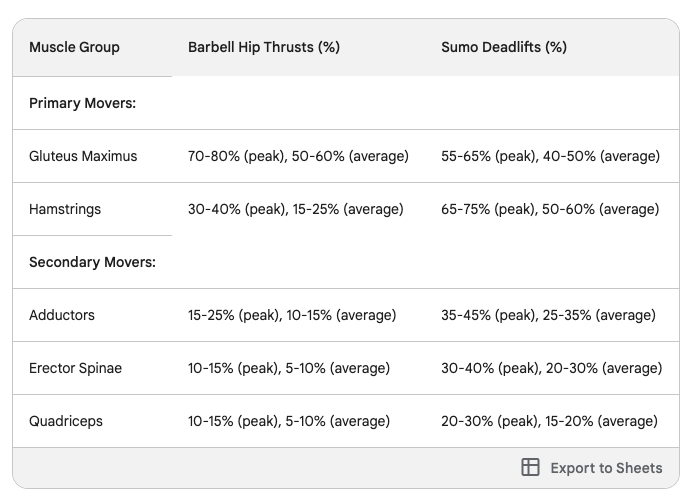
Biomechanical Analysis:
- Joint Movement Visuals: Animations and diagrams illustrated the range of motion at the hip, knee, and ankle joints during each exercise phase. These visually showcased the distinct biomechanical profiles:
- Barbell Hip Thrusts: Focus on isolated hip extension with minimal knee and ankle movement, emphasizing gluteus maximus focus.
- Sumo Deadlifts: Deeper hip hinge, wider stance, and slight plantar flexion at the ankle generate a more complex movement pattern, engaging multiple muscle groups.
- Force Distribution Visualizations: Visualizations highlighted the force distribution across the body during both exercises. These emphasized:
- Barbell Hip Thrusts: Concentrated force on the hip extensors, particularly the gluteus maximus, with minimal spinal loading, making them suitable for individuals with lower back concerns.
- Sumo Deadlifts: Force is distributed across multiple muscle groups, including gluteus maximus, hamstrings, adductors, erector spinae, and core, requiring greater overall stability and core engagement.
Muscle Activation Graphs:
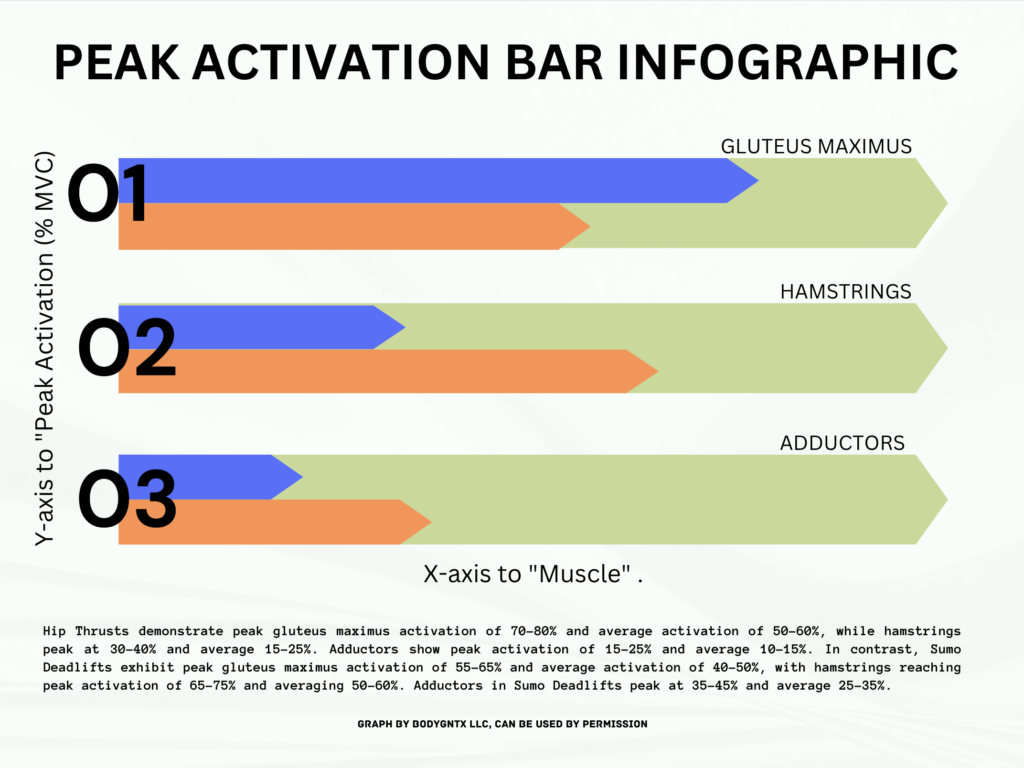
Discussion:
These findings, alongside the comprehensive biomechanical analysis, reveal key considerations for exercise selection based on specific training goals:
- Maximizing Gluteus Maximus Activation: Barbell Hip Thrusts excel due to their isolated focus on hip extension, providing the highest activation levels for this key mover. This is ideal for glute strengthening and hypertrophy in athletes and individuals seeking sculpted glutes.
- Comprehensive Hip Muscle Activation with Hamstring and Adductor Focus: Sumo Deadlifts, thanks to their deeper hip hinge and wider stance, effectively engage a broader range of hip muscles with substantial involvement of hamstrings and adductors. This is beneficial for athletes requiring balanced hip activation and improved power in movements like sprinting, jumping, and change of direction.
- Functional Movement Considerations: The biomechanical profile of Sumo Deadlifts resembles hip extension actions commonly seen in activities like sprinting and jumping, suggesting their potential in improving power and performance in these movements.
Limitations:
This study acknowledges limitations such as sample size and individual variations in anatomy, training experience, and technique. Future research should explore these factors and investigate:
- Functional Implications: Analyze how activation patterns and biomechanical characteristics translate to specific athletic skills and rehabilitation outcomes.
- Exercise Variations: Analyze modified versions of Barbell Hip Thrusts and Sumo Deadlifts to optimize muscle recruitment for individual needs and training goals.
- Individualized Prescription: Examine how factors like anatomy, training experience, and injury history influence exercise effectiveness and optimal selection.
Muscle activation of different exercise table form BodyGNTX LLC:
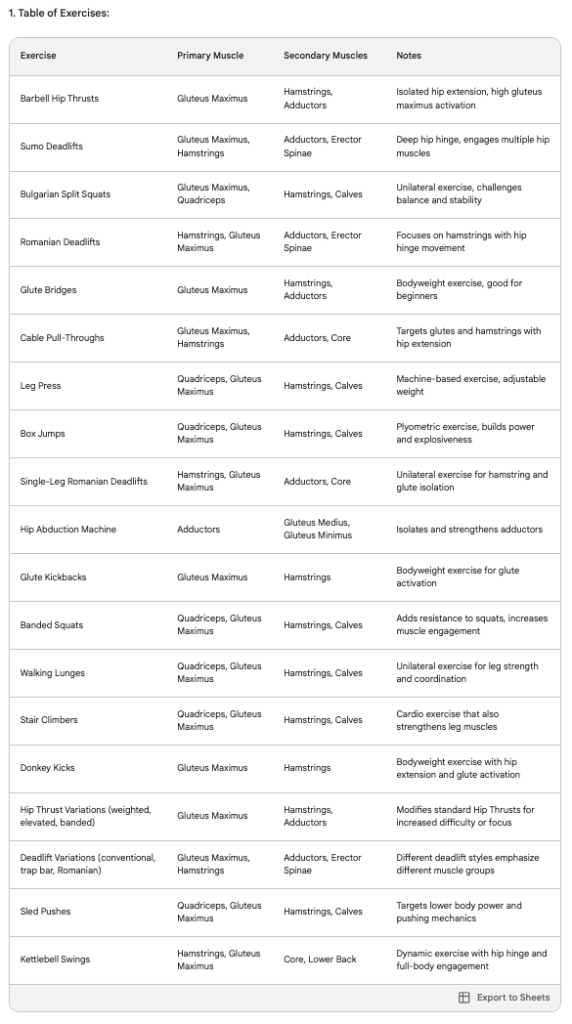
Practical Applications:
For Gluteus Maximus Focus:
- Prioritize Barbell Hip Thrusts: They excel at isolated hip extension, leading to the highest gluteus maximus activation (70-80% peak EMG). This makes them ideal for athletes and individuals seeking to strengthen and hypertrophy their glutes.
- Variations for Increased Glute Focus: Consider banded Hip Thrusts or weighted variations using dumbbells or plates. These add extra resistance, further pushing gluteus maximus activation.
- Mind-Muscle Connection: During Hip Thrusts, actively focus on squeezing your glutes at the top of the movement, maximizing muscle engagement and contraction.

For Comprehensive Hip Muscle Activation:
- Incorporate Sumo Deadlifts: Their deeper hinge and wider stance engage a broader range of hip muscles, including hamstrings and adductors, alongside the gluteus maximus. This is beneficial for athletes needing balanced hip activation and improved power in various movements.
- Alternative Exercises: Consider Romanian Deadlifts for a similar focus on hamstrings and glutes with a less demanding spinal load. Hip Abduction Machine can target adductors specifically.
- Training Sequence: To prioritize both glute strength and overall hip activation, consider performing Barbell Hip Thrusts early in your workout when fatigue is minimal, followed by Sumo Deadlifts or other compound exercises.
For Functional Movement Training:
- Mix Both Exercises: Both Hip Thrusts and Sumo Deadlifts target hip extension in complementary ways. Hip Thrusts build isolated strength, while Sumo Deadlifts mimic functional movement patterns with multi-muscle engagement.
- Plyometric Variations: Add variations like jump squats or box jumps to incorporate explosive power training, benefiting exercises like sprinting and jumping.
- Sport-Specific Training: Analyze movements specific to your sport and incorporate exercises that closely replicate the biomechanics, using both isolated and compound movements like Hip Thrusts and Sumo Deadlifts for a comprehensive approach.
Additional Considerations:
- Individual Preferences: Choose exercises you enjoy and can perform with proper technique. Experiment and find variations that suit your body and goals.
- Progressive Overload: Gradually increase weight, sets, or reps over time to keep challenging your muscles and promoting progress.
- Warm-up and Cool-down: Always dedicate time to warming up before workouts and cooling down afterward to prevent injuries and improve recovery.
By understanding the distinct activation patterns and biomechanical profiles of Barbell Hip Thrusts and Sumo Deadlifts, you can make informed choices based on your training goals and tailor your workout routines for optimal results. Remember, consistency and proper technique are key to unlocking the full potential of these exercises and achieving your desired muscle activation and performance.
Alternative resources related to the topic of hip muscle activation in Barbell Hip Thrusts and Sumo Deadlifts:
Journal Articles:
- Comparison of Muscle Activation Between the Conventional Deadlift, Sumo Deadlift and Stiff-Leg Deadlift: https://www.researchgate.net/publication/11432299_An_electromyographic_analysis_of_sumo_and_conventional_style_deadlifts This study compares the muscle activation of three deadlift variations, including Sumo Deadlifts.
- Barbell Hip Thrust, Muscular Activation and Performance: A Systematic Review: https://www.ncbi.nlm.nih.gov/pmc/articles/PMC6544005/ This review article summarizes existing research on the muscle activation of barbell hip thrusts.
- Electromyographic Comparison of Barbell Deadlift, Hex Bar Deadlift, and Hip Thrust Exercises: A Cross-Over Study: https://pubmed.ncbi.nlm.nih.gov/28151780/ This study compares the muscle activation of barbell deadlifts, hex bar deadlifts, and hip thrusts.
Books:
- Essentials of Strength Training and Conditioning, 4th Edition by Thomas R. Baechle and Roger W. Earle: https://us.humankinetics.com/products/essentials-of-strength-training-and-conditioning-4th-edition-hkpropel-access
- NSCA’s Essentials of Sport Conditioning and Performance Enhancement: https://www.nsca.com/globalassets/education/nsca_strength_and_conditioning_professional_standards_and_guidelines.pdf
- Anatomy of Strength Training by Frederic Delavier: https://www.amazon.com/Frederic-Delavier-Strength-Training-Anatomy-2nd/dp/B00HTK1SD2
- Starting Strength, 3rd Edition by Mark Rippetoe: https://epdf.mx/starting-strength-3rd-edition.html
- Scientific Principles of Strength Training by Vladimir Zatsiorsky: https://us.humankinetics.com/
Resource Websites:
- National Strength and Conditioning Association (NSCA): https://www.nsca.com/
- American College of Sports Medicine (ACSM): https://www.acsm.org/
- ExRx.net: https://exrx.net/Calculators
- Bodybuilding.com: https://www.bodybuilding.com/
- Stronger by Science: https://www.strongerbyscience.com/articles/
